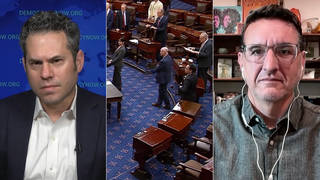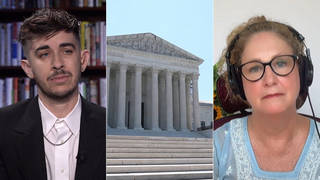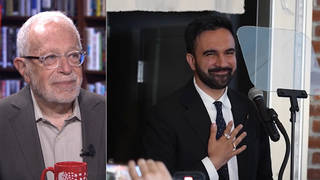
Guests
- Jamie FellnerSenior counsel in the US program at Human Rights Watch. Her latest report is called “Decades of Disparity: Drug Arrests and Race in the United States.”
- Deborah Smallexecutive director of Break the Chains, an organization that works within communities of color to replace current drug policies.
A new study underscores the severity of racial bias in drug-related law enforcement. According to Human Rights Watch, African Americans were arrested as much as five-and-a-half times as whites on drug charges every year for the past three decades. The trend dates back to 1980, the earliest date with complete data. [includes rush transcript]
Transcript
AMY GOODMAN:
As the New York State Assembly takes on one of the harshest drug laws in the nation, a new study underscores the severity of racial bias in drug-related law enforcement. According to Human Rights Watch, African Americans were arrested as much as five-and-a-half times as whites on drug charges every year for the past three decades. The trend dates back to the ’80s, the earliest date with complete data.
About one in three people arrested on drug charges are African American. The report says, “Jim Crow may be dead, but the drug war has never been color-blind. Although whites and blacks use and sell drugs, the heavy hand of the law is more likely to fall on black shoulders.”
The Human Rights Watch report is called “Decades of Disparity: Drug Arrests and Race in the United States.” I’m joined now by its author, Jamie Fellner, senior counsel in the US program at Human Rights Watch. I’m also joined by Deborah Small, a leading activist around the issue, executive director of Break the Chains, a group that works to reduce racial disparities in drug law enforcement.
In a moment, Deborah, I want to talk to you about international implications of the drug laws here and how they deal with this around the world. But Jamie Fellner, let’s go to you. You’ve just released “Decades of Disparity.” Talk about the situation today.
JAMIE FELLNER:
The situation today is a war on drugs that is skewed by race, and it always has been skewed by race. In fact, the history of drug laws in this country show that it’s very difficult to separate concerns about drugs from concerns about minorities. And certainly in the ’80s, the white politicians played the race card, calling it a crime card, to woo the anxious white electorate.
And yet, twenty-five years later, we still see that arrests are predominant — or disproportionately of black people, including blacks and Hispanics. But the data only breaks it down by race, white and black. And I think the reason is because race has always been used to define what do we think the drug problem is and what is the response to it. We could have used and should be using, I believe, a non-law enforcement approach to people with substance abuse problems. Instead, we’ve used a criminal law enforcement approach.
The other thing that the report shows is that most of the arrests — and this is historical, again, not just currently, but certainly currently, too — most of the arrests are for possession. I think the American public think the police are out there looking for major traffickers and dealers. And, in fact, they’re arresting people because they have some weed in their pocket or maybe a rock of crack. Eighty percent — for the last nine years, every year, 80 percent of arrests are for simply for possession. And in fact, four in ten arrests are for marijuana possession. And even though it’s a war now against marijuana, it’s still disproportionately blacks who are being arrested. So you have to ask yourself, what is going on?
AMY GOODMAN:
And in terms of who are the drug users and sellers, what is the proportion?
JAMIE FELLNER:
Blacks and whites engage in drug offenses at about the same rate. They use drugs and they sell drugs at about the same rate. Since there are six-and-a-half times as many whites in this country, you would think there would be then proportionally six-and-a-half times as many whites being arrested on drug charges.
But that’s not the case, because the police aren’t going into white homes, white bars, white neighborhoods, white offices to make drug arrests. They’re going into black neighborhoods. And if you go into black neighborhoods, that’s where you’ll be arresting black people. And I don’t think that’s — I mean, I hate to say it, but it’s not coincidental.
AMY GOODMAN:
What do you mean?
JAMIE FELLNER:
I think that there is a deliberate use of drug laws to — I think that there’s something in this country which can be called structural racism, which doesn’t require any individual policeperson or prosecutor or judge or anyone else to have malign intent. Nevertheless, there is what’s called a conspiracy of forces, of assumptions, of attitudes, of behaviors, which end up with the result that blacks get the short end of the stick.
AMY GOODMAN:
Deborah Small, let’s talk about this nationally, and then we’ll come back to this report — internationally. How do our drug laws compare to others?
DEBORAH SMALL:
Well, America, the United States, has among the harshest drug sentencing laws in the world. I just recently returned from a major drug law conference in New Zealand, which has a very high incarceration rate — it’s about the fifth highest in the world — and yet, they consider seven years to be a really stiff sentence, a harsh sentence, for any violation, a violent crime, including a drug crime. And when I told them that drug offenders routinely get sentences of ten, fifteen, twenty years or more, they were astounded, because most people around the world would never hand out the kind of sentences that we routinely give for drug-related offenses.
AMY GOODMAN:
A global conference is coming up?
DEBORAH SMALL:
Yes, the UN is about to engage — or has been engaged in a ten-year review of international drug control strategy. Ten years ago, they declared that by this point in time they wanted to achieve the goal of a drug-free world or significantly reduce the demand and supply of drugs. It’s very clear in 2008 and 2009 that we’ve come nowhere near that goal.
It’s interesting, though, because in the intervening ten-year period, many of the countries, particularly in western Europe and Latin America, have adopted harm reduction as one of the main components of their approach to addressing the problems of drugs, along with law enforcement, drug treatment and prevention. And harm reduction basically is a set of strategies that’s designed to help reduce the harms associated with drug use to both individuals and communities. So, needle exchange and overdose preventions are examples of harm reduction programs. The US has been willing to support those kinds of programs locally but is fiercely fighting the efforts of the Europeans and others to include harm reduction language in the document to be presented to the UN, on the basis that to do so would be endorsing drug legalization.
AMY GOODMAN:
We are seeing now an escalation of attention on the border right now, Jamie Fellner, with Mexico, and they’re talking about this as a terrorism threat, which has to do with what they’re calling the drug wars in Mexico and places like Ciudad Juarez. How does that affect dealing with legislation today in the United States and people incarcerated?
JAMIE FELLNER:
Well, I also wanted to note that three former presidents of Latin American countries have issued a statement based on a study, basically saying that the drug war has been a disaster for their countries. And in fact, I started working on US drug issues coming out of work on Colombia, where the coca is grown that ends up coming, much of it, here.
And I think it is important, as Deborah is doing, to look at the sort of whole international picture. As long as the United States is going to be consuming, there is going to be violence in Mexico, there is going to be violence in other countries that are producers. That’s one of the — you could almost take a harm reduction approach to this. The huge profits that come from drugs come from their being illegal. So these countries are the victims of all this violence, because the US consumer is paying such a premium based on the drugs being illegal. And it’s a Catch-22. It’s a vicious circle.
AMY GOODMAN:
What about the power of the prison lobby in the United States? I mean, correction officers, for example, in California, I think it’s something like the prison guard lobby is the second most powerful.
JAMIE FELLNER: Yeah.
AMY GOODMAN: We just had a discussion about the New York Rockefeller drug laws and about the fact that prisoners who come from New York City, sent Upstate, a tremendous industry to keep up the economy Upstate, largely white areas —-
JAMIE FELLNER: Mm-hmm.
AMY GOODMAN: —- are then counted in the Census as residents of those Upstate areas —-
JAMIE FELLNER: Right.
AMY GOODMAN: —- which then get representation in Congress. Of course, they don’t; they can’t even vote.
JAMIE FELLNER:
They can’t vote, of course, right. That’s not just true in New York. States — just about every state has used prisons as a rural economic engine, and many cities don’t want the prisons located there, so you see in state after state essentially minorities being taken from urban areas and sent to be residents, non-voting residents, in predominately white rural areas, in the prisons there.
It’s not just the prison guards. Here in New York, for example, and many places, prosecutors are fierce opponents of any reform to drug laws, not just because they truly believe that they’re the best interest of the community, because they know how futile it is, they see the same people coming through all the time, but because the laws since the mid-’80s have given them such huge power through the mandatory minimum. So what they charge, in essence, sets the terms of the debate, and judges are just bystanders in this process. And most people don’t want to give up power, and prosecutors are no different there. They do not want to give up the huge power that they have accrued over this time.
AMY GOODMAN:
What are you recommending with your report, the conclusions of “Decades of Disparity”?
JAMIE FELLNER:
Well, “Decades of Disparity” follows a number of reports we did just last year. We’ve released one on prison admissions, showing that blacks —-
AMY GOODMAN: We have thirty seconds.
JAMIE FELLNER: —- blacks go to prison at ten times the rate of whites on drug charges. We think you need a paradigm shift. It’s not about arresting more whites. It’s about looking at how — what we’re trying to do in the war on drugs. If we want to reduce drug use, let’s focus on substance abuse prevention and treatment rather than sending people to prison.
AMY GOODMAN:
We’re going to leave it there. I want to thank you both for being with us, Jamie Fellner, senior counsel at US program at Human Rights Watch, Deborah Small, executive director of Break the Chains, which works to replace current drug policies.













Media Options